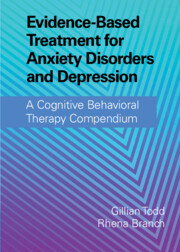 Evidence-Based Treatment for Anxiety Disorders and Depression
Evidence-Based Treatment for Anxiety Disorders and Depression Book contents
- Evidence-Based Treatment for Anxiety Disorders and Depression
- Evidence-Based Treatment for Anxiety Disorders and Depression
- Copyright page
- Contents
- Figures
- Tables
- Contributors
- 1 Introduction
- 2 The History and Philosophical Underpinnings of CBT:
- Part One Cognitive Behavioral Therapy for Anxiety Disorders
- Part Two Cognitive Behavioral Therapy for Posttraumatic Stress Disorder
- Part Three Cognitive Behavioral Therapy for Obsessive-Compulsive Disorder and Associated Disorders
- Part Four Cognitive Behavioral Therapy for Depression
- Part Five Complexity and Comorbidity in Anxiety Disorders and Depression:
- 22 Case Formulation for Complexity and Comorbidity in Anxiety Disorders and Depression
- 23 Treating Complexity and Comorbidity in Anxiety Disorders and Depression
- Part Six Specialist Applications of Cognitive Behavioral Therapy for Anxiety Disorders and Depression
- Part Seven Future Developments
- Appendices
- Index
- References
22 - Case Formulation for Complexity and Comorbidity in Anxiety Disorders and Depression
from Part Five - Complexity and Comorbidity in Anxiety Disorders and Depression:
Published online by Cambridge University Press: 06 January 2022
- Evidence-Based Treatment for Anxiety Disorders and Depression
- Evidence-Based Treatment for Anxiety Disorders and Depression
- Copyright page
- Contents
- Figures
- Tables
- Contributors
- 1 Introduction
- 2 The History and Philosophical Underpinnings of CBT:
- Part One Cognitive Behavioral Therapy for Anxiety Disorders
- Part Two Cognitive Behavioral Therapy for Posttraumatic Stress Disorder
- Part Three Cognitive Behavioral Therapy for Obsessive-Compulsive Disorder and Associated Disorders
- Part Four Cognitive Behavioral Therapy for Depression
- Part Five Complexity and Comorbidity in Anxiety Disorders and Depression:
- 22 Case Formulation for Complexity and Comorbidity in Anxiety Disorders and Depression
- 23 Treating Complexity and Comorbidity in Anxiety Disorders and Depression
- Part Six Specialist Applications of Cognitive Behavioral Therapy for Anxiety Disorders and Depression
- Part Seven Future Developments
- Appendices
- Index
- References
Summary
Anxiety disorders and depression are the most prevalent mental disorders, and although psychological interventions (particularly CBT) have been shown to be effective, treatment response is often suboptimal, given that, in many cases, patients have complex presentations and frequent comorbidities. Especially in such cases, a good case formulation is essential. Case formulation derives from the initial assessment and guides intervention by conceptualizing the presenting symptoms, the underlying etiological mechanisms, and their origin. A good conceptualization should successfully inform treatment and should be evidence-based, combining research data with personalized features of each case. According to the level of analysis, we can distinguish between case, diagnosis/presenting problem formulation, and symptom level/specific problem formulation. For complex and comorbid depression and anxiety disorders, we should include additional elements and also select the most appropriate conceptualization model for our particular case.
Keywords
- Type
- Chapter
- Information
- Evidence-Based Treatment for Anxiety Disorders and DepressionA Cognitive Behavioral Therapy Compendium, pp. 461 - 474Publisher: Cambridge University PressPrint publication year: 2022
